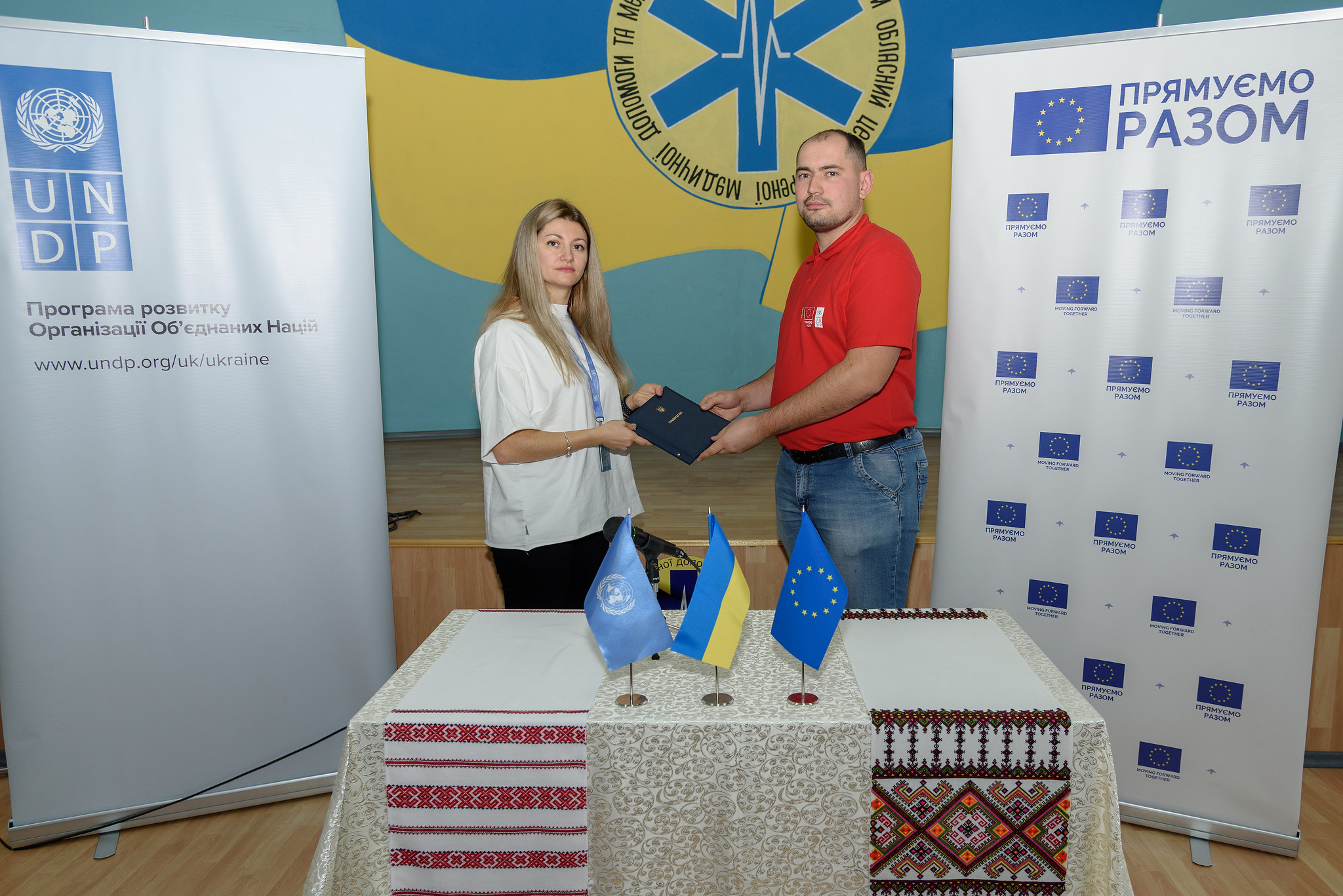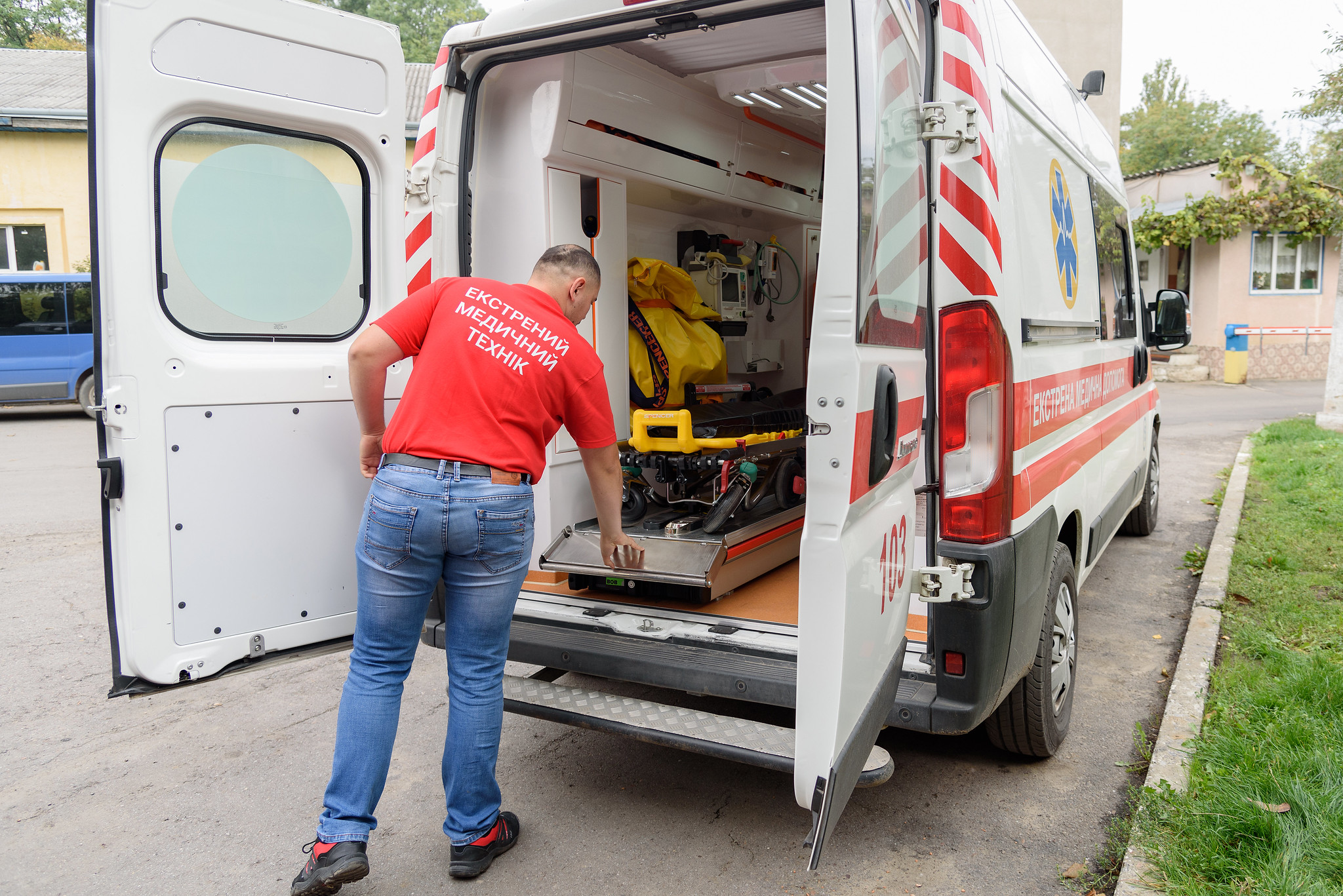How a 32-year-old Ukrainian found his purpose in life through UNDP-supported training in emergency medicine
Discovering destiny as an emergency medical technician in Ukraine
October 20, 2022

Yevhen Matiash, graduate of a UNDP-supported emergency medical technician (EMT) training course, in the ambulance where he now works.
Yevhen Matiash is a part of a team of highly qualified specialists that rushes into harm’s way to provide emergency assistance to those who need it. His work takes him into apartment buildings, rubble-strewn basements, and hard-to-reach places as a driver of field vehicles at the Chernivtsi Oblast Centre for Emergency Medical Aid and Disaster Medicine.
"I was always fascinated when, as a child, I watched American films where 911 arrived, two people ran out of an ambulance and professionally provided medical care," Yevhen recalls. "Unfortunately, we did not have this before in Ukraine. Only now has there been an opportunity to get an education and relevant skills, and, in my opinion, this is how it should be."

Yevhen Matiash presents some of the ambulance equipment he uses in the course of his work as an emergency medical technician.
The career of an emergency medical technician significantly impacts society through the thousands of lives they save. In moments of great stress, paramedics can keep calm and reassure patients, carrying out urgent organizational, diagnostic and treatment measures.
When the full-scale war in Ukraine began, Yevhen was at home in the city of Storozhyntsi, Chernivtsi Oblast. "I didn't sleep well and was restless that night. At 6 a.m. I turned on my mobile phone and saw a message from the President on the news that the war had begun."
Even though ambulance teams work far from the front lines, the workload increased significantly after the start of the full-scale war. "After 24 February, many calls from patients are related to the response to stressful events, such as high blood pressure, heart attacks and strokes,” Yevhen said. “These were the biggest reasons for calls during the first few months after the start of the war.”

Yevhen Matiash presents some of the ambulance equipment he uses in the course of his work as an emergency medical technician.
Yevhen used to be a computer specialist. His father worked in the ambulance brigade for almost 50 years but died of COVID-19. "At his funeral, I realised I needed to go into medicine to help people. Since my mother worked as a nurse, this is where I went. These events motivated me to try something new in my life."
In the summer of 2022, the United Nations Development Programme with the financial support of the European Union organized a series of professional training where ambulance drivers could master new first-aid practices to act safely and effectively. The courses were held at the Bakhmut Medical College, and the students mastered their practical skills with the Chernivtsi Oblast Centre of Emergency Medical Aid and Disaster Medicine trainers.

A UNDP specialist hands over a state certificate to Yevhen Matiash for successfully completing professional training in emergency medical services to become an emergency medical technician.
Yevhen had been thinking about training to become an emergency medical technician for a long time until a senior doctor called him and told him about the possibility of the courses to improve his qualifications. "Of course, I have been following this information for a long time, and I wanted such courses to be available in my country. That's why I was happy to enrol and complete the training," he said.
Yevhen noted that getting professional training as an emergency medical technician takes a long time. Hard work requires physical endurance, calmness in stressful situations, relevant medical knowledge, and the ability to make quick decisions even in harsh conditions. EMTs in Ukraine are certified with a state-model license to assist during various emergencies per the assigned duties. This is the provision of assistance as part of an emergency medical care team, interaction with other medical services, assessment of the external environment for possible threats to the technician or other people, assessment of the patient's condition and examination, resuscitation measures, patient transportation, etc.
Background
The training of emergency medical technicians is organised with the support of UNDP within the UN Recovery and Peacebuilding Programme with the financial support of the European Union.

 Locations
Locations

